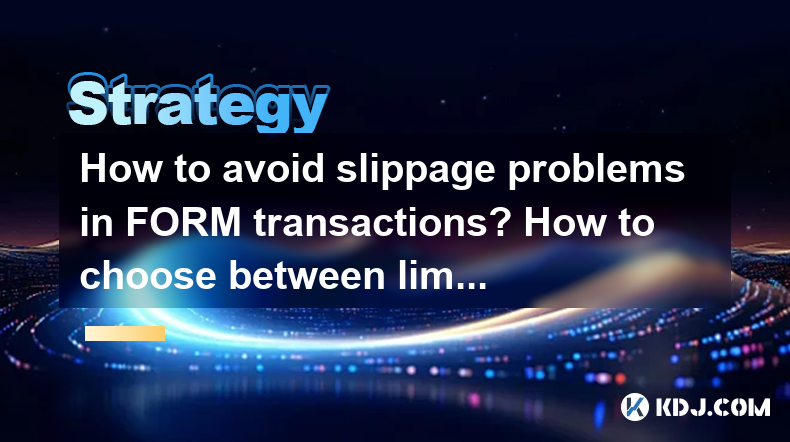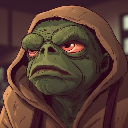-
 bitcoin
bitcoin $122659.385674 USD
0.52% -
 ethereum
ethereum $4484.113342 USD
-0.09% -
 bnb
bnb $1304.229256 USD
-0.85% -
 tether
tether $1.000204 USD
-0.03% -
 xrp
xrp $2.860636 USD
-0.51% -
 solana
solana $227.288799 USD
2.36% -
 usd-coin
usd-coin $0.999805 USD
0.01% -
 dogecoin
dogecoin $0.252837 USD
1.18% -
 tron
tron $0.341149 USD
1.12% -
 cardano
cardano $0.830507 USD
0.33% -
 hyperliquid
hyperliquid $45.792319 USD
0.04% -
 chainlink
chainlink $22.422164 USD
1.55% -
 ethena-usde
ethena-usde $1.000283 USD
0.01% -
 sui
sui $3.511389 USD
0.83% -
 stellar
stellar $0.385276 USD
-0.44%
How to avoid slippage problems in FORM transactions? How to choose between limit orders and market orders?
Slippage in FORM transactions can be minimized by using limit orders, trading during high liquidity periods, and breaking up large orders to control price impact.
May 02, 2025 at 10:21 pm

Slippage in cryptocurrency transactions, particularly within the context of FORM transactions, can pose a significant challenge for traders. Slippage refers to the difference between the expected price of a trade and the actual price at which the trade is executed. This can occur due to high volatility, low liquidity, or delays in transaction processing. To minimize slippage, it's crucial to understand and utilize different order types effectively. This article will explore how to avoid slippage problems in FORM transactions and guide you on choosing between limit orders and market orders.
Understanding Slippage in FORM Transactions
Slippage in FORM transactions happens when the price at which you want to buy or sell a token shifts between the time you place your order and when it is executed. This is particularly common in decentralized exchanges (DEXs) where liquidity can be lower than on centralized platforms. For instance, if you aim to buy FORM at $1.00 but the market moves to $1.05 by the time your transaction is processed, you experience slippage of $0.05 per token.
To minimize slippage, traders need to consider several factors:
- Liquidity: Higher liquidity generally leads to lower slippage. Ensure you trade on platforms with sufficient liquidity for FORM.
- Volatility: High volatility increases the risk of slippage. Monitor market conditions before placing large orders.
- Transaction Speed: Faster transaction processing can reduce the chance of price changes.
Strategies to Avoid Slippage in FORM Transactions
There are several strategies traders can employ to minimize slippage when trading FORM:
- Use Limit Orders: Limit orders allow you to specify the maximum price you're willing to pay when buying or the minimum price you're willing to accept when selling. This can help control slippage by ensuring your order only executes at your specified price or better.
- Trade During High Liquidity Periods: Liquidity tends to be higher during certain times of the day or week. Trading during these periods can reduce the risk of slippage.
- Adjust Slippage Tolerance: Some decentralized exchanges allow you to set a slippage tolerance percentage. Setting a higher tolerance can increase the chances of your order being filled but at the cost of potential higher slippage.
- Break Up Large Orders: Instead of placing a single large order, consider breaking it into smaller ones. This can reduce the impact on the market price and minimize slippage.
Choosing Between Limit Orders and Market Orders
When deciding between limit orders and market orders for FORM transactions, it's essential to consider your trading goals and the current market conditions.
Limit Orders are best used when:
- You want to control the exact price at which your order is executed.
- You are willing to wait for the market to reach your specified price.
- You aim to minimize slippage.
To place a limit order for FORM:
- Open your trading platform and navigate to the FORM trading pair.
- Select the option to place a limit order.
- Enter the amount of FORM you want to buy or sell.
- Specify the limit price at which you want your order to execute.
- Review and confirm your order.
Market Orders are suitable when:
- You prioritize speed over price.
- You are willing to accept whatever the current market price is.
- You want to ensure your order is executed immediately.
To place a market order for FORM:
- Open your trading platform and navigate to the FORM trading pair.
- Choose the option to place a market order.
- Enter the amount of FORM you want to buy or sell.
- Review and confirm your order.
Advantages and Disadvantages of Limit and Market Orders
Limit Orders offer the advantage of price control and can help minimize slippage. However, they may not be executed if the market does not reach your specified price, potentially missing out on trading opportunities.
Market Orders ensure immediate execution, which is beneficial in fast-moving markets. The downside is that they are susceptible to slippage, especially in volatile or illiquid markets, as they are filled at the best available price at the time of execution.
Practical Tips for Minimizing Slippage
Here are some practical tips to further minimize slippage when trading FORM:
- Monitor Market Depth: Before placing a large order, check the order book to understand the depth of the market. This can give you an idea of how much your order might move the price.
- Use Stop-Loss Orders: A stop-loss order can help limit your losses if the market moves against you. However, be aware that stop-loss orders can also be affected by slippage.
- Stay Informed: Keep up with news and events that could impact FORM's price. Sudden news can cause volatility, increasing the risk of slippage.
Frequently Asked Questions
Q: Can slippage be completely eliminated in FORM transactions?A: No, slippage cannot be completely eliminated due to the inherent nature of cryptocurrency markets. However, by using the strategies outlined above, you can significantly reduce its impact.
Q: How does the choice of trading platform affect slippage in FORM transactions?A: The choice of trading platform can significantly affect slippage. Platforms with higher liquidity and faster transaction processing times generally result in lower slippage. Always research and choose platforms that are known for their efficiency and liquidity when trading FORM.
Q: Is it better to use limit orders or market orders when trading FORM during high volatility?A: During high volatility, limit orders are generally safer as they allow you to set a specific price, helping to control slippage. However, if immediate execution is crucial, a market order might be necessary, though it comes with a higher risk of slippage.
Q: How can I assess the liquidity of FORM on a trading platform?A: To assess the liquidity of FORM on a trading platform, you can look at the order book, trading volume, and the bid-ask spread. A narrower bid-ask spread and higher trading volume indicate higher liquidity, which can help minimize slippage.
Disclaimer:info@kdj.com
The information provided is not trading advice. kdj.com does not assume any responsibility for any investments made based on the information provided in this article. Cryptocurrencies are highly volatile and it is highly recommended that you invest with caution after thorough research!
If you believe that the content used on this website infringes your copyright, please contact us immediately (info@kdj.com) and we will delete it promptly.
- US Treasury, Bitcoin, and Reserve Expansion: A New Era?
- 2025-10-10 02:45:12
- Trading Bots & AI Algorithms: Your 2025 Edge
- 2025-10-10 02:45:12
- Monero and Zcash: Privacy Coins Spark Price Breakout
- 2025-10-10 02:45:38
- Zora Crypto Price Jumps After Robinhood Listing: A New York Minute on the Altcoin Scene
- 2025-10-10 02:25:16
- Digital Gold: Future of Ownership and Investment in the Crypto Age
- 2025-10-10 02:45:38
- BlockDAG, Formula 1, and Crypto Investing: A Winning Combination for Mainstream Adoption
- 2025-10-10 03:05:16
Related knowledge

Practical parameter settings for a Bitcoin multi-timeframe moving average system
Sep 18,2025 at 10:54pm
Optimizing Timeframe Combinations for Bitcoin Trading1. Selecting appropriate timeframes is crucial when building a multi-timeframe moving average sys...

How can I filter out false breakouts in Dogecoin high-frequency trading?
Sep 22,2025 at 01:00am
Understanding False Breakouts in Dogecoin Trading1. A false breakout occurs when Dogecoin's price appears to move beyond a defined support or resistan...

Techniques for identifying tops and bottoms in the Bitcoin on-chain NVT model
Sep 20,2025 at 07:54pm
Understanding the NVT Model in Bitcoin Analysis1. The Network Value to Transactions (NVT) ratio is often described as the 'P/E ratio' of the cryptocur...

What does the surge in open interest in Bitcoincoin futures mean?
Sep 20,2025 at 11:18pm
Understanding the Surge in Dogecoin Futures Open Interest1. A surge in open interest within Dogecoin futures indicates a growing number of active cont...

How can I use the Ethereum USDT premium to gauge market sentiment?
Sep 18,2025 at 11:55pm
Understanding the Ethereum USDT Premium1. The Ethereum USDT premium refers to the price difference between USDT (Tether) traded on Ethereum-based plat...

What should I do if Ethereum staking yields decline?
Sep 20,2025 at 06:18am
Understanding the Causes Behind Declining Ethereum Staking Yields1. The Ethereum network transitioned to a proof-of-stake consensus mechanism with the...

Practical parameter settings for a Bitcoin multi-timeframe moving average system
Sep 18,2025 at 10:54pm
Optimizing Timeframe Combinations for Bitcoin Trading1. Selecting appropriate timeframes is crucial when building a multi-timeframe moving average sys...

How can I filter out false breakouts in Dogecoin high-frequency trading?
Sep 22,2025 at 01:00am
Understanding False Breakouts in Dogecoin Trading1. A false breakout occurs when Dogecoin's price appears to move beyond a defined support or resistan...

Techniques for identifying tops and bottoms in the Bitcoin on-chain NVT model
Sep 20,2025 at 07:54pm
Understanding the NVT Model in Bitcoin Analysis1. The Network Value to Transactions (NVT) ratio is often described as the 'P/E ratio' of the cryptocur...

What does the surge in open interest in Bitcoincoin futures mean?
Sep 20,2025 at 11:18pm
Understanding the Surge in Dogecoin Futures Open Interest1. A surge in open interest within Dogecoin futures indicates a growing number of active cont...

How can I use the Ethereum USDT premium to gauge market sentiment?
Sep 18,2025 at 11:55pm
Understanding the Ethereum USDT Premium1. The Ethereum USDT premium refers to the price difference between USDT (Tether) traded on Ethereum-based plat...

What should I do if Ethereum staking yields decline?
Sep 20,2025 at 06:18am
Understanding the Causes Behind Declining Ethereum Staking Yields1. The Ethereum network transitioned to a proof-of-stake consensus mechanism with the...
See all articles


























![🚨IS VECHAIN (VET) A DEAD COIN ?? PRICE ANALYSIS [GET READY NOW] 🚨IS VECHAIN (VET) A DEAD COIN ?? PRICE ANALYSIS [GET READY NOW]](/uploads/2025/10/09/cryptocurrencies-news/videos/vechain-vet-dead-coin-price-analysis-ready/68e7b200b067b_image_500_375.webp)















































